Oaxaca

Pronunciation: wah-HAH-kah.
Origin of state name: The name of the state comes from the Náhuatl (the language of the Aztecs) word Hauxyacac, which means "on the top of the guaje tree." The guaje tree is common throughout the state.
Capital: Oaxaca de Juárez (wah-HAH-kah deh HWAH-rehs), named for the former president Benito Juárez (1806–1872).
Entered country: October 13, 1824.
Coat of Arms: An eagle perched on a cactus with a snake in its beak forms the top of the symbol. The shield below contains an oval encircled by the motto "El Respeto Al Derecho Ajeno es La Paz", with symbols of the state's archeology.
Holidays: Año Nuevo (New Year's Day—January 1); Día de la Constitución (Constitution Day—February 5); Benito Juárez's birthday (March 21); Primero de Mayo (Labor Day—May 1); Revolution Day, 1910 (November 20); and Navidad (Christmas—December 25).
Flag: There is no official state flag.
Time: 6 AM = noon Greenwich Mean Time (GMT).
1 Location and Size
Oaxaca is located on the southern coast of Mexico. It is the fifth-largest state with an area of 95,364 square kilometers (36,820 square miles), which is a little larger than the US state of Indiana. Oaxaca is bordered on the north by the Mexican states of Puebla and Veracruz; on the east by the Mexican state of Chiapas; on the south by the Pacific Ocean; and on the west by the Mexican state of Guerrero. Oaxaca is divided into 570 municipalities. Its capital is Oaxaca de Juárez.
In the central Oaxaca Valley, in the west on the Isthmus of Tehuantepec (an isthmus is a narrow strip of land that connects two larger areas, in this case the Bay of Campeche on the north and the Gulf of Tehuantepec on the south), and along the coast, the land is flat. But Oaxaca is also one of the most mountainous states in Mexico. The state is crossed by three great mountain ranges ( sierras ): the Sierra Madre del Sur, the Sierra Madre Oriental (also known as the Sierra de Oaxaca), and the Sierra Atravesada. Canyons and caves also are found throughout the state.
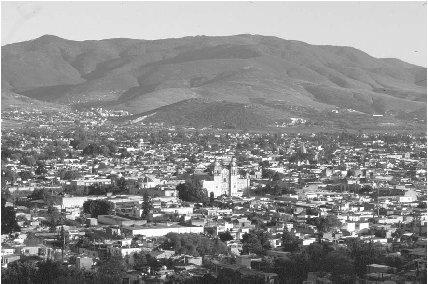
Panoramic view of the capital.
The largest river is the Río Papaloapan, which forms when several small rivers join near the border with Veracruz.
In Oaxaca, the most beautiful waterfalls are the Salto de Conejo, Cabdadihui, Yatao, Salto de Fraile, and Apaola. The largest lagoons are found near the Pacific coast. They are the Chacahua and Manialtepec lagoons in the coastal region, and the Superior and Inferior lagoons on the Isthmus of Tehuantepec.
2 Climate
The climate is moderate all year. The average winter temperature is 17° c (63° f ) in November, December, and January. From May to August, the average temperature is 22° c (72° f ). The average rainfall in Oaxaca de Juárez is 69.5 centimeters (27.4 inches) per year. Rainfall for the entire state ranges from a minimum average of about 42.7 centimeters (16.8 inches) to a maximum average of about 375 centimeters (147 inches). Oaxaca occasionally is struck by damaging hurricanes, such as Hurricane Pauline in October 1997.
3 Plants and Animals
Oaxaca has about thirty thousand different plant species. Some of the most common trees are oyamel trees, ahuehuete (cypress), cedar, mahogany, ash, oak, and
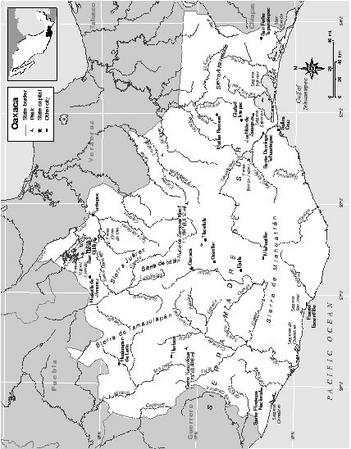
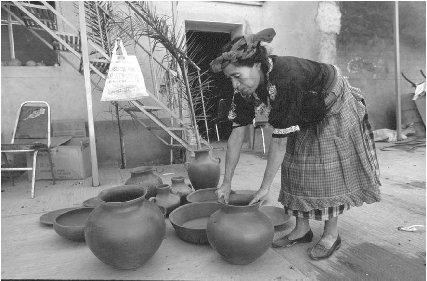
A woman with her pottery.
4 Environmental Protection
The Lagunas de Chacahua National Park (lah-GOO-nahs dai chah-KAH-wah) is a protected area on the coast with many bamboo groves and mangrove swamps. In 2002, eight communities in Oaxaca began local conservation efforts as part of a Community Protected Areas program. These new Community Protected Areas are focused on efforts to preserve the Mexican dry forest on the Pacific coast and the Mesoamerican Pine-Oak forest in Sierra Norte.
5 Population, Ethnic Groups, Languages
Oaxaca had a total population of 3,438,765 in 2000; of the total, 1,657,406 were men and 1,781,359 were women. The population density was 37 people per square kilometer (96 people per square mile). In 2000, the capital, Oaxaca de Juárez, had a population of 256,848.
There are sixteen different indigenous (native) groups that are formally registered within the state. They include the Zapotec, Amuzgos, Chochos, Huaves, and others. There is also a group known as the Afromixtecas, who represent an ethnic mix of the Mixteca and the African slaves who were brought to Mexico by the Spanish. Most citizens speak Spanish as their first language. About 37.2% of the population speaks indigenous languages. This is the second highest percentage in the country (after Yucatan).
6 Religions
According to the 2000 census, 74% of the population, or about 2.6 million people, were Roman Catholic; about 7%, or 234,150 people, were Protestant. That year there were also 25,986 Seventh-Day Adventists, 37,504 Jehovah's Witnesses, and 1,199 Jews. Almost 150,000 people reported no religion.
7 Transportation
Oaxaca Airport provides international flights to and from Oaxaca. The state has about 15,569 kilometers (9,670 miles) of roads and 651 kilometers (450 miles) of railroads.
8 History
Some archeological ruins that date back to more than 11,000 B . C . make Oaxaca the first place where human settlements occurred in Mexico. Olmec culture developed in the region around 3,000 B . C . Quiché culture first emerged around 2,000 B . C . The archeological ruins of Monte Albán were built around 800 B . C . Zapoteca Indians built large irrigation systems in the Oaxaca Valley around 800 A . D . during the early centuries of the Christian era. Mexica Indians populated the region starting around 1200 A . D . The Aztecs founded the city of Oaxaca and dominated the other indigenous groups and cultures in the mid-14th century.
When the Spaniards first arrived and Spanish conqueror Hernan Cortés (1485–1547) sought to defeat the Aztec empire in Tenochtitlán-Mexico (ancient name of Mexico City), some of Cortés's envoys went to the region and made peace with the Chinanteco Indians. Mexica Indians, however, continued to resist Spanish occupation until 1522. At that time Francisco de Orozco and Pedro de Alvarado (c. 1485–1541) completed the conquest of the region for the Spanish crown. Attempts to convert the native Oaxaca Indians to Christianity had begun in 1521. In 1529, Cortés, seeking to protect territories that he hoped to retain for himself, ordered the destruction of many villages that were founded by Spanish soldiers and conquistadors (those who sought to take control of Mexico for Spain). Internal land conflicts among the Spanish colonizers and the resistance of several indigenous groups made the region somewhat unstable for a few years after the conquest. Cortés introduced sugarcane and wheat to his vast territories. Agricultural production soon consolidated as the main economic engine in the region.
By the 16th century, the indigenous population had been decimated. Diseases brought by the Europeans, overexploitation for agricultural purposes, and widespread famine brought defeat. Yet, agricultural production
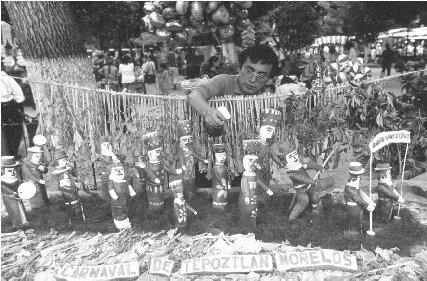
Examples of radish art displayed during El Festival de los Rábanos (Festival of the Radishes) held in December each year.
Mexican priest and revolutionist José María Morelos y Pávon (1765–1815) brought the independence movement to Oaxaca in 1812. A later attempt by a Spanish royalist army sent from Guatemala to regain control of Oaxaca failed. Defeat was at the hands of a militia army led by another Mexican priest and patriot Mariano Matamoros (1770–1814). Later, after Morelos's downfall, Spanish royalists regained control of Oaxaca until the region joined the rest of Mexico in declaring independence with the Plan of Iguala in 1821. Oaxaca became a federal state of Mexico in 1824.
The unstable period that marked the reign of Antonio López de Santa Anna (1794–1876), who was in and out of power from the early 1830s to the mid 1850s, ended when Benito Juárez (1806–1872), Oaxaca's most revered son, emerged as a local and national leader in the 1850s. (Juárez officially became president of Mexico in 1858). Another Oaxaca notable leader, Porfirio Díaz (1830–1915), successfully resisted the efforts by French troops to take control of Oaxaca. (The French, under the leadership of Emperor Maximilian [1832–1867], briefly controlled parts of Mexico from 1863 to 1867.) With the triumph of the Reforma movement led by Juárez, Oaxaca joined the rest of Mexico in supporting the liberal government that brought about radical and profound reforms. Juárez, a native indigenous himself, died in 1872 while serving as president. Porfirio Díaz, Juárez's former ally and political opponent when Juárez last served as president, eventually became president himself in 1877. His rule came to an end with the Mexican Revolution of 1910.
During Juárez's and Díaz's tenures, Oaxaca developed as an agricultural, financial, and commercial center. Díaz extended the railroads well into the state and brought telegraph lines to the major cities. Toward the end of Díaz's reign, many of the leaders in Oaxaca supported him against the revolutionaries who were opposed to the aging president taking on yet another presidential term. However, a few revolutionary revolts sparked throughout the state. After Díaz abandoned the presidency and left Mexico, military conflicts reached Oaxaca as well.
After the revolution, Oaxaca evolved as a tourist, commercial, and agricultural center. Because of its extremely rich archeological heritage and numerous ancient religious and historic sites, Oaxaca is also considered the birthplace of much of Mexico's legendary history and traditions.
9 State and Local Government
The state governor is democratically elected every six years. Immediate re-election is not allowed. The legislature is comprised of a forty-two-member unicameral (single chamber) congress. Twenty-five deputies are elected in single member districts, and seventeen deputies are elected by proportional representation, all for three-year periods. Immediate re-election is not allowed. The Institutional Revolutionary Party (PRI) continues to dominate the state government.
The 570 municipalities that comprise Oaxaca hold democratic elections for municipal presidents and council members every three years. Immediate re-election is not allowed. Because of the widely varying size and financial resources of the different municipalities, decentralization efforts have produced mixed results in recent years.
10 Political Parties
The three main political parties in all of Mexico are the Institutional Revolutionary Party (PRI), the National Action Party (PAN), and the Party of the Democratic Revolution (PRD). The PRI has been the historically dominant party in state politics throughout the 20th century. After the Mexican Revolution, only PRI candidates have won the gubernatorial races. Most recently, José Murat won the 1998 gubernatorial race, defeating PAN and PRD candidates. PAN and PRD have gained electoral strength in recent years and have successfully captured important municipal governments.
11 Judicial System
The Superior Tribunal of Justice is the highest court in the state. The governor appoints members for renewable fifteen-year terms, with legislative approval. Justices
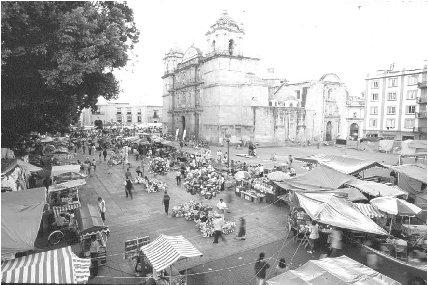
Alameda Park in the capital surrounds the cathedral. Each December, it is filled with market stalls during El Festival de los Rábanos (Festival of the Radishes).
12 Economy
Most of the people in Oaxaca work in agriculture. However, service-based industries are growing in importance. Agriculture accounts for about 15% of the state economy. However, finance and insurance companies account for 20% of the economy and general service-based companies account for 22%. Trade accounts for 16% of the economy, followed by manufacturing at 14%, transportation and communications at 8%, construction at 4%, and mining at 1%.
13 Industry
Most manufacturing companies are located in the central valley regions, the Tuxtepec region, and on the Tehuantepec Isthmus. Industry is only a small part of the nation's total economy. There is, however, a large oil refinery at Salina Cruz that
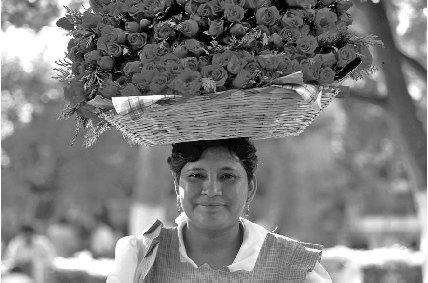
A flower vendor wears her inventory on her hat.
Oaxaca is well-known for its handicrafts. These include clothing, pottery, and wood and leather items. Handicrafts are usually produced by individual artists. Some communities have small-scale production of handicrafts by groups of workers.
14 Labor
The US Bureau of Labor Statistics reported that Mexican workers saw their wages increase 17%, from $2.09 per hour in 1999 to $2.46 per hour in 2000. (The average US worker earned $19.86 per hour in 2000.) After one year, workers are entitled by law to six days paid vacation.
15 Agriculture
Most of the citizens of Oaxaca are farmers. The most important crops are mangoes and coffee. Oaxaca produces more mangoes than any other Mexican state. Oaxaca is the third largest producer of coffee. Corn and beans are the major crops for local consumption. Other important crops include squash, avocado, oranges, sugarcane, and tobacco. Most of the livestock are beef and dairy cattle. A festival every December celebrates the radish, which
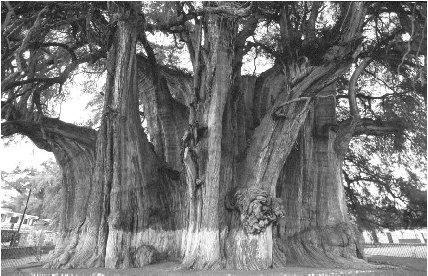
This 2,000-year-old ahuehuete (cypress) tree is known as El Tule. It is believed to be the world's largest tree, with a circumference of nearly 140 feet (42 meters).
16 Natural Resources
Though Oaxaca has a wide variety of fish, the fishing industry has not been developed to its full potential. Shrimp are a popular catch. Forests cover about half of the land area in the state, with most forest areas belonging to local communities. Wood is cut primarily for fuel and building material, but there are some small businesses that produce furniture, plywood, and paper. Gold, silver, lead, copper, and zinc are all found in state mines.
17 Energy and Power
Almost all of the energy in Mexico is provided by the Federal Electricity Commission (CFE). In February 2002, the CFE introduced new electric rates. For households that use less than 140 kilowatt hours per month, there was no rate increase. (This is about 75% of all households in Mexico, according to CFE). There is a small project to generate electricity using wind power.
18 Health
The state of Oaxaca has 40 general hospitals, 1,218 outpatient centers, and 65 surgical centers.
Most of the Mexican population is covered under a government health plan. The IMSS (Instituto Mexicano de Seguro Social) covers the general population. The ISSSTE (Instituto de Seguridad y Servicios Sociales de Trabajadores del Estado) covers state workers.
19 Housing
Only about one-fourth of the housing available in the state of Oaxaca is in good repair. More than 47% is in need of significant upgrading. Many homes do not have running water or access to electricity.
20 Education
The system of public education was first started by President Benito Juárez in 1867. Public education in Mexico is free for students from ages six to sixteen. According to the 2000 census, there were approximately 885,000 school-age students in the state. Many students elect to go to private schools. The thirty-one states of Mexico all have at least one state university. The Benito Juárez University of Oaxaca is located in the state.
21 Arts
Oaxaca has three local performing companies: the Contemporary Dance Company of Oaxaca; Mírame, a musical group; and Pasatono, a group performing indigenous music. There are also seven theaters and dozens of local cultural centers. Oaxaca is also famous for its painted animals made of copal wood, native to the area. Also black clay pottery is a native craft.
22 Libraries and Museums
Oaxaca has 413 branches of the national public library. Among the thirty museums in the state, the best known is the archeological site of Monte Albán, a pre-Columbian settlement. Oaxaca also has a stamp museum, a museum of graphic arts, a museum of contemporary arts, and a cultural museum.
23 Media
In the capital, Oaxaca, there are two daily newspapers: El Impartial and Noticias.
24 Tourism, Travel, and Recreation
The beaches of Huatulco, forty-minutes by airplane trip from the capital, Oaxaca, are clean and natural. Tangolunda Bay draws tourists interested in the environment. Visitors to the Huatulco area enjoy water sports, scuba diving, snorkeling, and fishing. The coastal village of Puerto Escondido is a main tourist resort. The city of Oaxaca features beautiful colonial architecture. Oaxaca is famous for its black clay pottery artifacts. The Fiestas of Lunes del Cerro is held during the last two weeks of July each year. The streets of the cities and towns are filled with music and performers in this festival celebrating the state's heritage. The Festival de los Rábanos in December features specially grown oversized radishes, carved into works of art. Some of the radishes reach over seven pounds (15 kilograms) in weight, 18 inches (50 centimeters) in length, and 5 inches (12 centimeters) in width.
25 Sports
Oaxaca has a baseball team, the Guerreros, which plays in the 8,000-seat L. E. Vasconcelos stadium.
26 Famous People
Benito Juárez (1806–1872) was a Zapotec Indian who was born on March 21, 1806, in the Oaxaca village of San Pablo Guelatao. He served as president of Mexico for two terms. He is considered to be one of the most beloved Mexican leaders. His birthday is a national holiday. Porfirio Díaz (1830–1915) was a dictator who ruled Mexico from 1877 until 1911. Juana Inés de la Cruz (1651–1695), a 17th-century feminist writer, and Rufino Tamayo (1899–1991), a renowned Mexican painter, were also natives of Oaxaca.
27 Bibliography
Books
Carew-Miller, Anna. Famous People of Mexico. Philadelphia: Mason Crest Publishers, 2003.
DeAngelis, Gina. Mexico. Mankato, MN: Blue Earth Books, 2003.
Sacks, Oliver W. Oaxaca Journal. Washington, DC: National Geographic Society, 2002.
Supples, Kevin. Mexico. Washington, DC: National Geographic Society, 2002.
Web Sites
Mexico for Kids. http://www.elbalero.gob.mx/index_kids.html (accessed June 15, 2004).
Surfing & Adventure Travel in Mexico: The State of Oaxaca. http://www.surf-mexico.com/states/Oaxaca/ (accessed June 17, 2004).